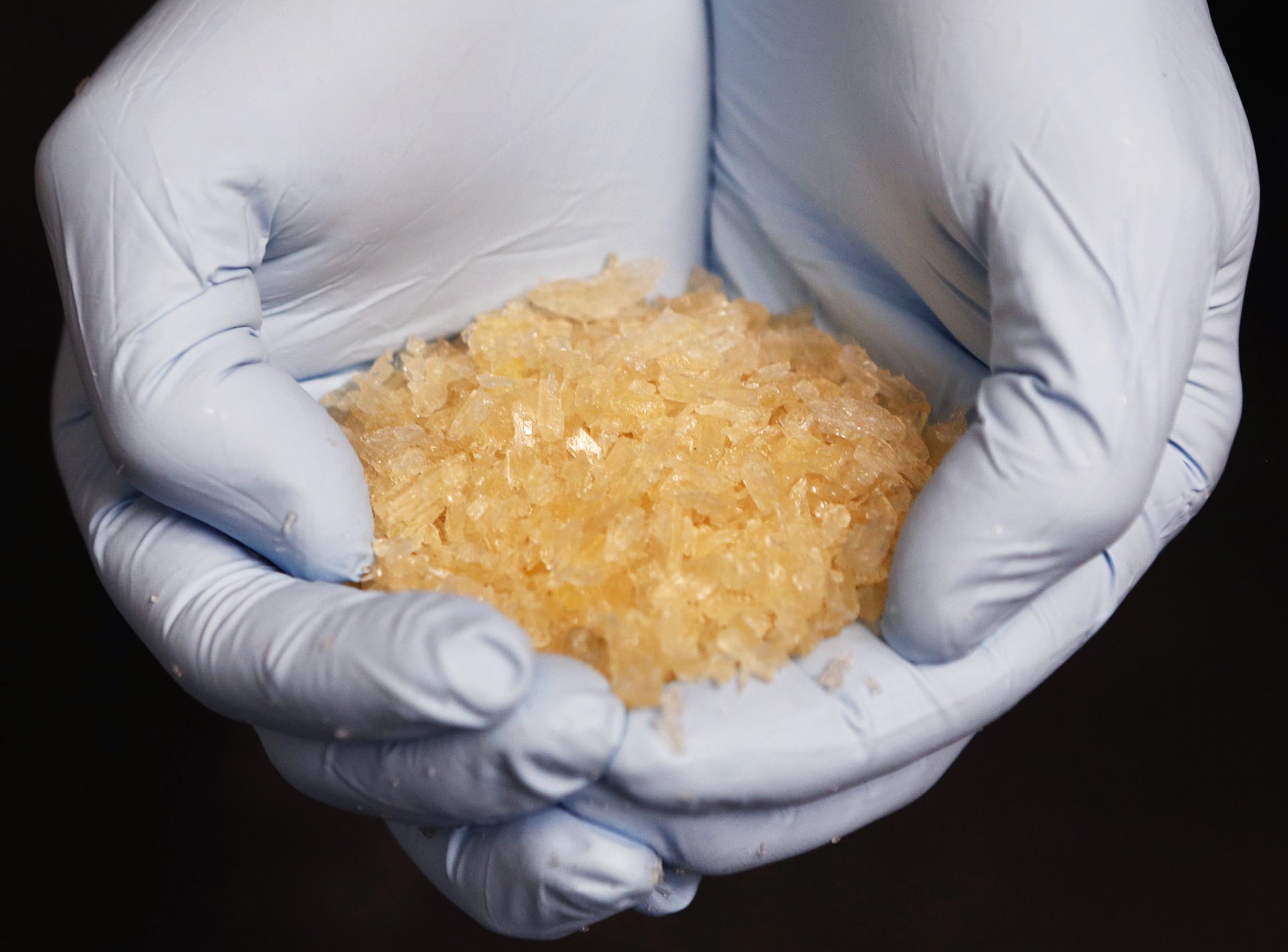
A criminal expert shows crystal meth at the German federal police in Wiesbaden, Germany, Thursday, Nov.13, 2014. (AP Photo/Michael Probst)


A criminal expert shows crystal meth at the German federal police in Wiesbaden, Germany, Thursday, Nov.13, 2014. (AP Photo/Michael Probst)
Billion-dollar lawsuits and prestige television shows have made the opioid epidemic impossible to overlook. But it is far from the only drug epidemic the country — and Oklahoma — are facing.
Overdose deaths from opioids, including prescription drugs as well as illicit forms such as fentanyl, have increased over the past few years, likely because of struggles amid the pandemic. But one drug in particular is killing Oklahomans at an even higher rate: methamphetamine.
In 2021, Oxycodone overdoses killed 43 Oklahomans, according to state data. Fentanyl killed 299. Meth killed 603.
“More Oklahomans than ever were being exposed to and becoming addicted to opioids with seriously high consequences,” said Jessica Hawkins, Director of Community and Systems Initiatives for the Healthy Minds Oklahoma Policy Initiative. “So it makes perfect sense why for many years opioids have been a focus. It’s understandable that the general public may not have heard of our stimulant problem in some time.”
The opioid epidemic obscured the problem Oklahoma has with methamphetamines, but also worsened it.
“We have referred to this as sort of the fourth wave of the opioid epidemic in our paper,” Hawkins said.
She said the country has seen this cycle before — an opiate epidemic followed by a stimulant epidemic. For example, heroin followed by cocaine and crack cocaine in the eighties and nineties. It’s obviously a complex situation, but a few factors at play are efforts to quit opiates and access to stimulants.
“There is a perception that meth is safer, it’s a safer alternative to opioids and could even reduce their overdose risk,” she said.
This is not true. Also, unlike opiates, there is no overdose reversal medication for methamphetamine — no Narcan equivalent.
“Opioid availability has changed, thankfully, and there have been more conservative prescribing practices and increased understanding of the addiction risk change in pain guidelines, it has changed the nature of what’s available in the community,” Hawkins said. “And availability matters. So in a situation in which somebody with substance use disorder cannot access opioids more easily than they can methamphetamine right now, the methamphetamine supply is less expensive than opioids.”
Availability of methamphetamine hasn’t dropped off. It might seem that way because it’s not as visible as it used to be.

In this March 25, 2004 file photo, medications containing pseuduoephedrine sit on a store shelf in Midwest City, Okla. Oklahoma authorities have been at the forefront of the nation’s battle against methamphetamine, but they will soon have a tough new opponent: the politically connected, well-heeled pharmaceutical industry. At issue is a proposal to require a prescription for certain cold tablets containing pseudoephedrine, which is used to make meth. Prosecutors say the measure is essential to controlling the meth trade. Drug companies are eager to keep their pills on store shelves. (AP Photo/Sue Ogrocki, File)
“It went from being sourced by local cooks who would cook their own supply to being sourced by the drug cartels,” Mark Woodward, the spokesman for the Oklahoma Bureau of Narcotics.
He noted lawmakers passed legislation in the early 2000s that essentially eradicated local meth production.
“The headlines disappeared because you weren’t seeing the fires and the contaminated properties and the children being pulled from a meth lab in the middle of the night,” he said.
“I think our height was in 2003 where we got almost 1400 meth labs, and those were the ones we found.”
The next year, the Legislature passed laws that required pharmacies to keep Sudafed — a major component of homemade methamphetamine — behind the counter, and put limits on how much residents could buy.
“It was really the silver bullet to stop meth labs,” Woodward said. “What we said from the beginning, though, is this will not stop meth.”
Hawkins says that one of the very few benefits of the opioid epidemic has been newfound public support for substance abuse treatment programs. And that existing community-based opioid treatment organizations have laid the groundwork for more methamphetamine treatment as well. For StateImpact, I’m Catherine Sweeney.
This story is the first of a series from StateImpact on Oklahoma and its methamphetamine epidemic.